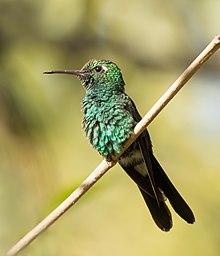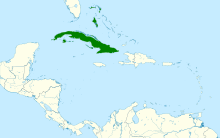The Cuban emerald (Riccordia ricordii) is a species of hummingbird in the "emeralds", tribe Trochilini of subfamily Trochilinae. It is found in the Bahamas and Cuba.[4][3]
| Cuban emerald | |
|---|---|

| |
| Male | |

| |
| Female both R. r. recordii at Palpite, Cuba | |
| Scientific classification | |
| Domain: | Eukaryota |
| Kingdom: | Animalia |
| Phylum: | Chordata |
| Class: | Aves |
| Clade: | Strisores |
| Order: | Apodiformes |
| Family: | Trochilidae |
| Genus: | Riccordia |
| Species: | R. ricordii
|
| Binomial name | |
| Riccordia ricordii (Gervais, 1835)
| |

| |
| Range of C. ricordii | |
| Synonyms | |
|
Chlorostilbon ricordii[3] | |
Taxonomy and systematics
editThe Cuban emerald was formerly placed in the genus Chlorostilbon. Based on a molecular phylogenetic study published in 2014 and a 2017 publication, the North American Classification Committee of the American Ornithological Society, the International Ornithological Committee (IOC), and the Clements taxonomy moved it to the resurrected genus Riccordia.[5][6][7][4][8] However, as of 2020 BirdLife International's Handbook of the Birds of the World (HBW) retained it in Chlorostilbon.[3]
The Cuban emerald is monotypic. However, the extinct Brace's emerald (R. bracei) was at one time treated as a subspecies of it.[9]
Description
editMale Cuban emeralds are 10.5 to 11.5 cm (4.1 to 4.5 in) long and females 9.5 to 10.5 cm (3.7 to 4.1 in). The species weighs between 2.5 and 5 g (0.088 and 0.18 oz). Males have a short, slightly decurved, black-tipped bill whose mandible is dull black and the maxilla red. It has a small whitish spot behind the eye. Its upperparts are dark shining green with a bronze tinge; the crown is darker and duller. Its underparts are mostly iridescent metallic green with white undertail coverts. The tail is deeply forked. Its innermost four pairs of feathers are dark metallic bronze to greenish bronze and the outermost pair similar with dark brown inner webs. Female's upperparts are similar to the male's. It has a longer whitish spot behind the eye. The underparts are mostly brownish gray with metallic green flanks and white undertail coverts. The tail is less forked than the male's but colored similarly.[9]
Distribution and habitat
editThe Cuban emerald is found on the main island of Cuba, the large Isla de la Juventud (Isle of Pines), and several smaller offshore cays. It is also found on Grand Bahama, Great Abaco, Andros, and Green Cay and occasionally as a stray on other islands in the Bahamas. It inhabits a variety of wooded habitats. On mainland Cuba it mostly occurs in both arid and humid open forest and on Grand Bahama in pine woods and coastal scrub forest. It also occurs in parks, gardens, and plantations. In elevation it ranges from sea level to at least 1,300 m (4,300 ft) but there are records at almost 2,000 m (6,600 ft) on Cuba.[9]
Behavior
editMovement
editThe Cuban emerald is generally sedentary but makes some local elevational dispersal.[9] It has been reported as a vagrant in Florida at least 14 times but the AOS considers the records "unsubstantiated" and it is not on the official Florida state list.[10][11]
Feeding
editThe Cuban emerald forages for nectar at a variety of flowering trees and shrubs, generally staying below about 6 m (20 ft) of the ground. It also feeds on small insects captured by hawking from a perch and sometimes by gleaning from spider webs.[9]
Breeding
editThe Cuban emerald can breed at any time of the year, but is thought to do so in Cuba mainly between April and July. It makes a cup nest of plant fiber, moss, and bark woven together with spider web and often covered with lichen and bits of bark. It places the nest in a fork, usually between 1 and 4 m (3 and 10 ft) above the ground. The female incubates the clutch of two eggs for 15 to 16 days and fledging occurs 19 to 22 days after hatch.[9]
Vocalization
editThe male Cuban emerald's high-pitched song is "a rapid rolling series of 'slee' notes and sputtering metallic sounds". Females give a "high-pitched 'seeeee' flight call". They also make "a buzzy 'zzzir'" and "chi-di-dit" calls.[9]
Status
editThe IUCN has assessed the Cuban emerald as being of Least Concern, though its population size and trend are not known. It does have a large range and no immediate threats have been identified.[1] It is considered common in most of its range and readily uses human-made habitat.[9]
References
edit- ^ a b BirdLife International (2016). "Cuban Emerald Chlorostilbon ricordii". IUCN Red List of Threatened Species. 2016. Retrieved 29 July 2022.
- ^ "Appendices | CITES". cites.org. Retrieved 2022-01-14.
- ^ a b c HBW and BirdLife International (2020) Handbook of the Birds of the World and BirdLife International digital checklist of the birds of the world Version 5. Available at: http://datazone.birdlife.org/userfiles/file/Species/Taxonomy/HBW-BirdLife_Checklist_v5_Dec20.zip [.xls zipped 1 MB] retrieved 27 May 2021
- ^ a b Gill, F.; Donsker, D.; Rasmussen, P., eds. (January 2022). "Hummingbirds". IOC World Bird List. v 12.1. Retrieved January 15, 2022.
- ^ McGuire, J.; Witt, C.; Remsen, J.V.; Corl, A.; Rabosky, D.; Altshuler, D.; Dudley, R. (2014). "Molecular phylogenetics and the diversification of hummingbirds". Current Biology. 24 (8): 910–916. doi:10.1016/j.cub.2014.03.016. PMID 24704078.
- ^ Stiles, F.G.; Remsen, J.V. Jr.; Mcguire, J.A. (2017). "The generic classification of the Trochilini (Aves: Trochilidae): Reconciling taxonomy with phylogeny". Zootaxa. 4353 (3): 401–424. doi:10.11646/zootaxa.4353.3. PMID 29245495.
- ^ "Check-list of North and Middle American Birds". American Ornithological Society. June 29, 2021. Retrieved August 9, 2021.
- ^ Clements, J. F., T. S. Schulenberg, M. J. Iliff, S. M. Billerman, T. A. Fredericks, J. A. Gerbracht, D. Lepage, B. L. Sullivan, and C. L. Wood. 2021. The eBird/Clements checklist of Birds of the World: v2021. Downloaded from https://www.birds.cornell.edu/clementschecklist/download/ Retrieved August 25, 2021
- ^ a b c d e f g h Bündgen, R. and G. M. Kirwan (2021). Cuban Emerald (Riccordia ricordii), version 1.1. In Birds of the World (J. del Hoyo, A. Elliott, J. Sargatal, D. A. Christie, and E. de Juana, Editors). Cornell Lab of Ornithology, Ithaca, NY, USA. https://doi.org/10.2173/bow.cubeme1.01.1 retrieved July 29, 2022
- ^ Check-list of North American Birds (7th ed.). Washington, D.C.: American Ornithologists' Union. 1998. p. 292.
- ^ "Official Florida State Bird List". Florida Ornithological Society. June 22, 2021. Retrieved July 29, 2022.
External links
edit- Cuban emerald photo gallery at VIREO (Drexel University)
Further reading
edit- Garrido, Orlando H.; Kirkconnell, Arturo (2000). Field Guide to the Birds of Cuba. Ithaca, NY: Comstock, Cornell University Press. p. 144. ISBN 978-0-8014-8631-9.
